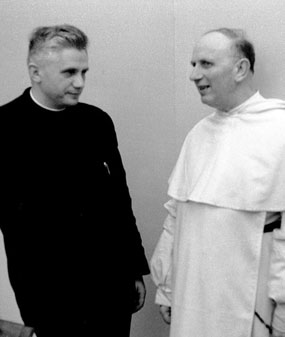 Did anything happen at the Second Vatican Council?
Did anything happen at the Second Vatican Council?
That’s the debate underlying the burgeoning disputes over the pope’s latest moves–the lifting of excommunications on four far-right schismatic Traditionalist bishops. In the post below on the topic, I cited comments by a leading church historian, Father Joseph Komonchak of Catholic University of America.
By happenstance–or Providence–Fr. Komonchak has a very good cover story in the current (Feb. 2, 2009) America magazine on the very topic of Joseph Ratzinger’s views of the council, and how they connect to the rehabiliation of the schismatics. (That is young Father Ratzinger, a peritus, or expert, at right at the council with the great Dominican Yves Congar, who was once silenced by Rome.)
The article, “Novelty in Continuity: Pope Benedict’s interpretation of Vatican II,” is a very good and insightful read. I think Fr. Komonchak bends over backward to put a positive spin on Benedict’s tough remarks toward those who see the council as a reforming event in the life of the church. And I think Benedict is disingenuous as best in trying to coopt for his own “continuity” camp the mantle of “reform.” In effect, the pope has to redefine what “reform” means. But then Fr. Komonchak might include me among the “careless commentators” who see Benedict among those advocating a “hermenuetic of continuity.”
In the context of the current dust-up, however, of great interest is Komonchak’s point about who Benedict was really trying to persuade with his December 2005 talk about the Council:
I think it is more plausible that the pope sought to persuade a different group of people, traditionalists whose rejection of the council derives in no small part from their belief that its teachings on church and state and on religious freedom represent a revolutionary discontinuity in official church doctrine. Archbishop Marcel Lefebvre, for example, had severely criticized the statement of then-Cardinal Ratzinger that Gaudium et Spes, Dignitatis Humanae and Nostra Aetate represented “a revision of the Syllabus, a kind of counter-syllabus…an attempt at an official reconciliation with the new age inaugurated in 1789.” These texts, Ratzinger said, rightly left behind the one-sided and obsolete stances adopted under Pius IX and Pius X; it was time for the church to “relinquish many of the things that have hitherto spelled security for her and that she has taken for granted. She must demolish long-standing bastions and trust solely to the shield of faith.”
Archbishop Lefebvre regarded these comments as “liberal banalities,” indifferent to or even scorning the support the church received from the Catholic confessional state and its institutions. Union of church and state, Lefebvre argued, “is a principle of Catholic doctrine as immutable as the doctrine itself.” Lefebvre’s successor, Bernard Fellay, invoked these paragraphs of Ratzinger in a letter in 2002 as an illustration of the points of serious disagreement that remain between Rome and Ecône. His group could never accept “any heterogeneous development of doctrine,” like what the council taught about religious freedom.
Pope Benedict’s talk on the interpretation of Vatican II could be read, then, as an effort at persuading traditionalists that a distinction is legitimately made between the level of doctrine or principle and the level of concrete application and response to situations.
